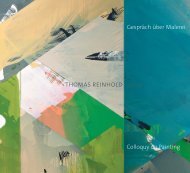You also want an ePaper? Increase the reach of your titles
YUMPU automatically turns print PDFs into web optimized ePapers that Google loves.
Historically, the beginnings of this concept of realism can be found in the painting of the 1960s,<br />
which later (in the 1970s) came to be known as ‘analytical painting’. Robert Ryman, in particular,<br />
might be mentioned here as a representative of it, as might Marcia Hafif and other artists (see<br />
page 6).<br />
2. Spontaneity, which can occur when comprehending connections (Cezanne’s famous “realiser”)<br />
within manifest experiences with physical actions, and which constitutes and determines<br />
an essential aspect of this realism. A spontaneity which first acquires creative form and becomes<br />
art within the context of process and reality.<br />
It is said that art, as far as its spontaneity and comprehension of contexts is concerned, is not<br />
only conceptually, but also intentionally determined, so that although pictorial ideas do indeed<br />
arise from understanding or from reason, they are never simply derived from them alone, but<br />
rather are also directed by simultaneous comprehension of the diversified content and material<br />
of our ways of seeing things. No content of our senses – and not only insofar as it is registered<br />
S. Seite 24 / see page 24<br />
by us – can dispense with a form [or, as it is so aptly put in medieval philosophy: matter is constantly<br />
predetermined, designated], and every content is, to a certain extent, likewise already<br />
directed and determined (i.e. intentionalised), so that unformed matter then simply becomes<br />
a myth. Matter, together with our view of it, is also constantly to be seen and understood in<br />
relation to and in connection with content, even if this – as absurd as it may sound – lies in the<br />
future, in the future as reflected by us. At the same time, it is never so determined in the present<br />
that no further determination (lat. intentio), or even innumerable determinations, would not<br />
make details of it clearer. However, this also entails restoring to the views and experiences,<br />
according to their [designated] material, guiding functions, dispositions which represent possible<br />
orientations and therefore possible actions.<br />
9<br />
Pictorial ideas do not derive from the senses. Of course not! However, they probably do arise<br />
when coupled with the powers of imagination [the senses in combination with understanding<br />
and reason], or as the German word Ein-Bildung (imagination) itself so beautifully suggests,



